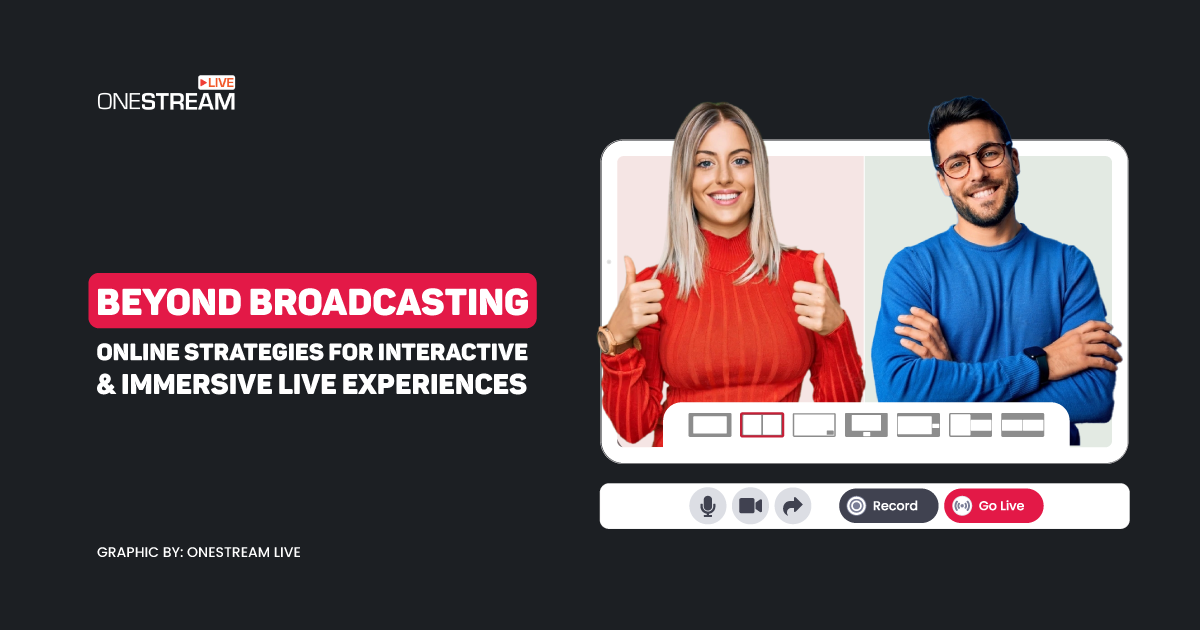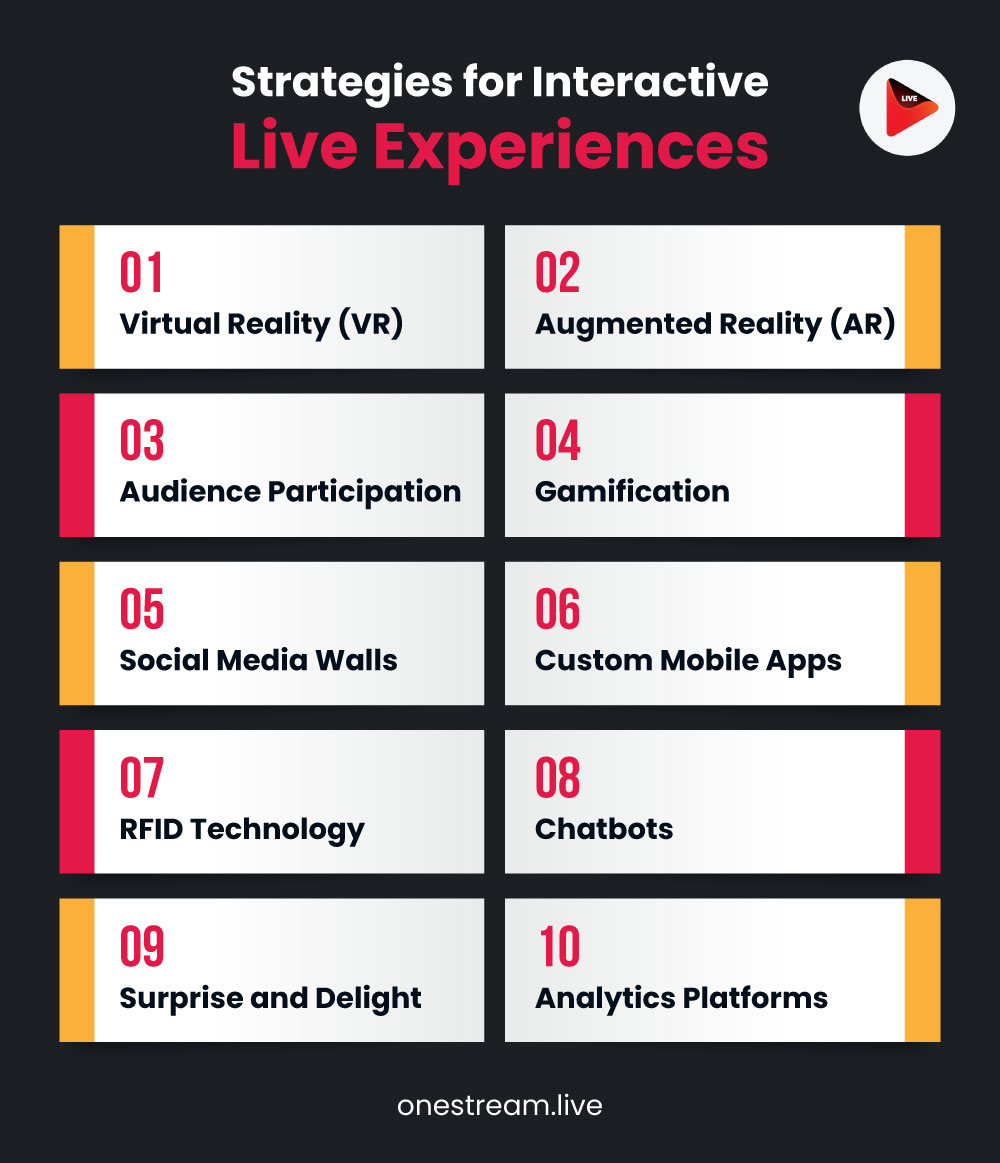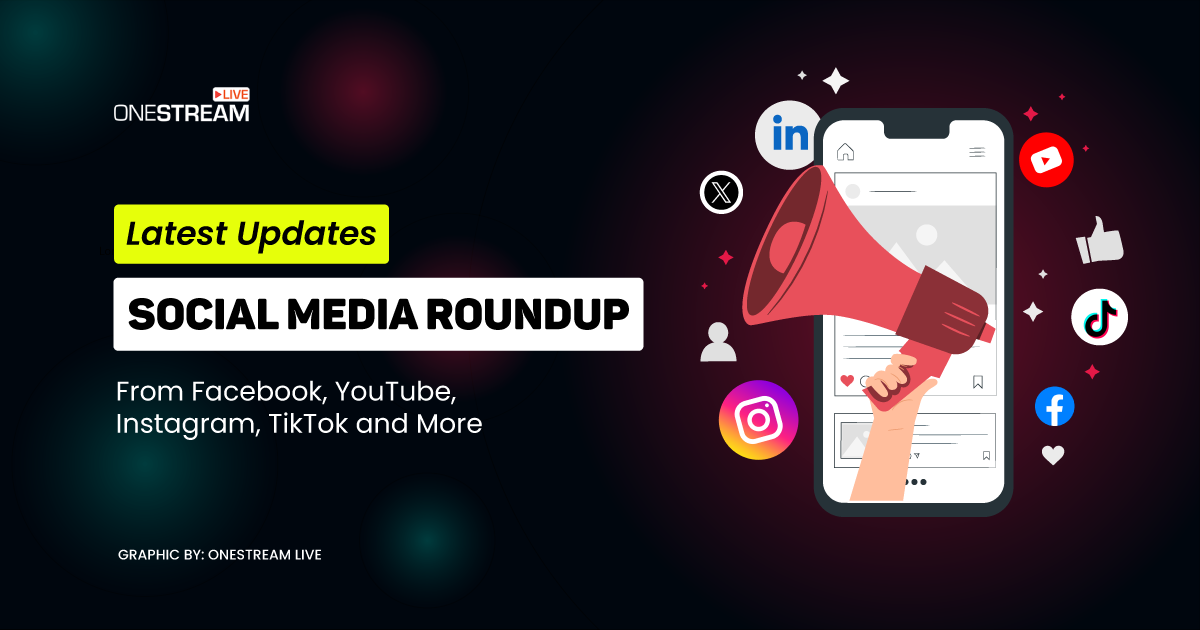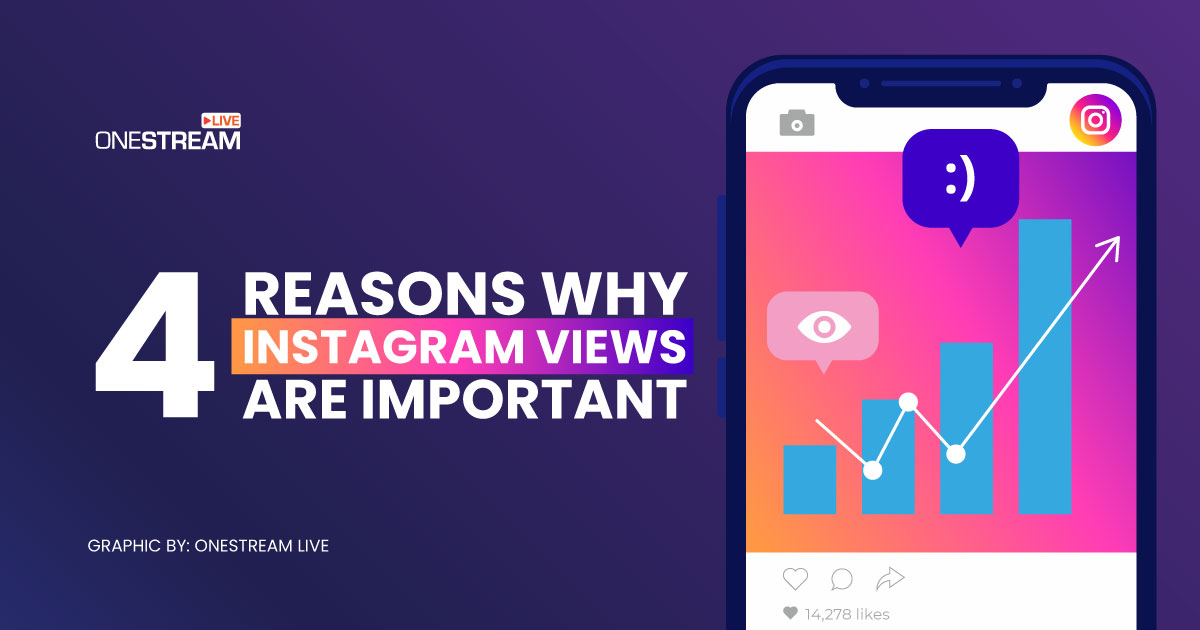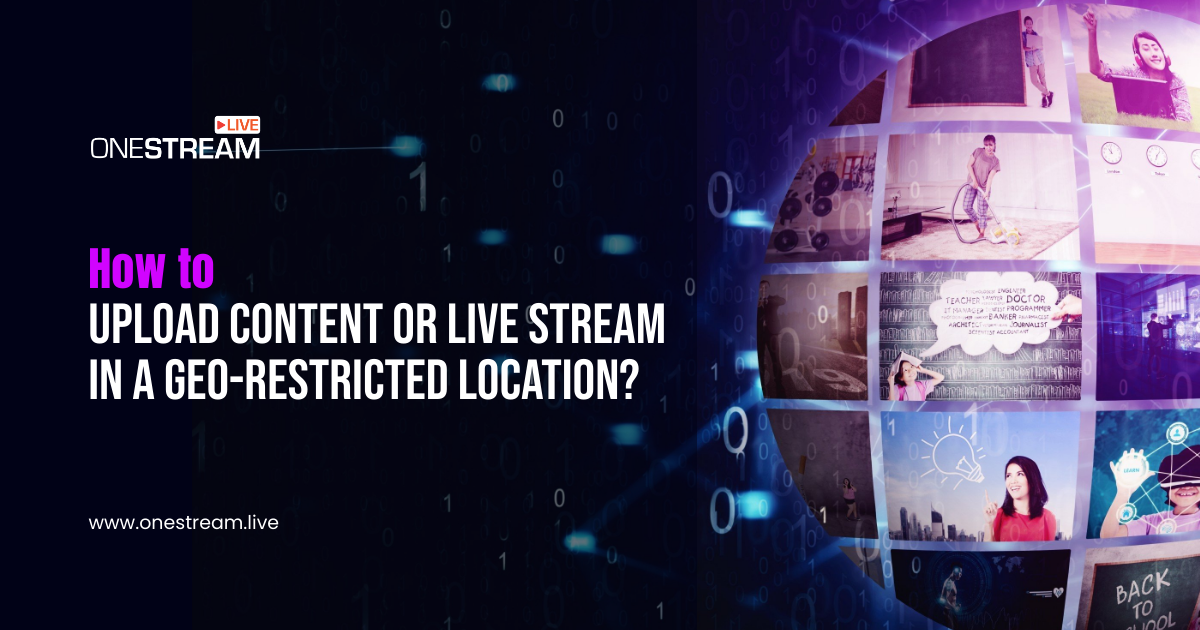Broadcast technologies, particularly broadcast TV, are quite familiar to the older generations and introduced everyone to mass media and live news coverage. However, broadcast media falls short compared to live experiences in its lack of interactivity, geographical restrictions, and limited on-demand access. Live streaming, on the other hand, keeps viewers engaged, transcends borders, and provides content anytime, anywhere.
In this Article:
This ubiquitous reach and interactivity make live experiences the de facto standard in all media forms, marketing, and digital communications with customers, potential customers, and brand adopters. We will examine several ways interactive and immersive live experiences can be enhanced to provide more value for your company’s or organization’s offerings.
10 Online Strategies for Interactive & Immersive Live Experiences
1.Virtual Reality (VR)
Virtual Reality (VR) technology creates an artificial, computer-generated environment. Unlike traditional screens, VR immerses the user in a completely simulated world through special headsets that project images and sounds directly in front of your eyes and ears.
It transcends the limitations of conventional screens, and this immersive quality opens up novel online experiences. Picture your users exploring a 3D virtual museum exhibit, closely examining artifacts, or attending a concert from the front row, interacting with performers. VR also has the potential to revolutionize education by creating lifelike learning environments—medical students can practice virtual surgeries, and architects can navigate 3D building models.
Businesses also benefit: Imagine trying on clothes in a virtual dressing room, customizing your dream car, or virtually touring a property before purchase. VR streamlines your live experiences of shopping by enhancing product visualization and offering remote training for employees.
2. Augmented Reality (AR)
Unlike VR, which creates a completely new world, Augmented Reality (AR) blends the digital with the real. AR overlays digital elements onto your physical surroundings, enhancing online live experiences in various ways. Perhaps the most popular AR implementation people are familiar with is the game Pokemon Go.
AR can revolutionize learning and shopping. Imagine interactive textbooks or virtually placing furniture in your living room to see how it looks. It can also gamify the real world with treasure hunts or location-based games. Additionally, AR can improve navigation by overlaying directions or storing information in your view of the world.
While VR fully immerses you in a simulated world, AR keeps you connected to your real surroundings. VR requires special headsets, whereas AR can be accessed through smartphones or tablets. Think of what you can do and how to enhance your live streams with these interactive features!
3. Audience Participation
Live polls, Q&A, gamification, and co-creation are all interactive elements that can transform a passive live stream into an engaging and dynamic live experience. Here’s how each one fuels real-time interaction.
Live Polls:
- Instantly gauge audience sentiment on a topic, fostering participation.
- Allows viewers to directly influence the direction of the live stream.
Q&A:
- Provides a platform for viewers to ask questions in real time, fostering a two-way dialogue.
- Encourages active listening and deeper engagement with the content being presented.
Co-creation:
- Allows viewers to contribute to the content of the live stream directly.
- This could involve brainstorming ideas, creating stories together, or even influencing the outcome of a live event.
- Fosters a sense of community and ownership among viewers.
Incorporating these elements allows you to transform your live experience from a one-way broadcast into a collaborative and interactive event.
4. Gamification
Gamification is the art of incorporating game mechanics and design elements into non-game contexts. Essentially, it takes games’ engaging and motivating aspects—points, badges, leaderboards, and challenges—and applies them to situations that are not traditionally games.
Integrating gamification can significantly enhance live streams and live experiences. By transforming passive viewers into active participants, it leverages our natural desire for competition and achievement.
Some examples are as follows:
- Live Trivia or Quiz Games: Host interactive trivia sessions about your stream’s topic. Award points for correct answers and create a leaderboard to showcase top participants.
- Polls with Challenges: Incorporate polls into your live Q&A. Challenge viewers to predict the outcome of a survey or offer bonus points for the most creative answer choices.
- Interactive Challenges: Designate live challenges related to your content. For example, during a live art tutorial, challenge viewers to recreate a specific technique and share their work to be featured.
- Unlocking Content & Rewards: Offer exclusive content or early access to features for viewers who reach certain milestones in your gamified system.
5. Social Media Walls
Social media walls are streams of curated social media posts (tweets, photos) with a designated hashtag. They become interactive hubs for your live presentations. Viewers can share their thoughts, reactions, or creations. They provide real-time feedback on your event and promote user-generated content.
Some notable examples you can use are:
- Live Q&A: Social media walls can display audience questions, allowing you to address more questions.
- Product Launches: Showcase user posts with the product hashtag to create launch buzz.
- Live Events: Display audience tweets with the event hashtag to boost engagement and promote the event.
- Live Streaming Contests: Use social media walls to display contest entries and fuel audience participation.
6. Custom Mobile Apps
Custom mobile apps designed and developed specifically for a particular purpose or organization are valuable. Unlike generic apps in app stores, custom apps cater to the unique needs and functionalities desired by the user or business.
Here’s how custom mobile apps can enhance live experiences:
- Event Apps: Enhance festivals, conferences, or sports events with custom apps offering schedules, maps, speaker info, and live updates.
- Live Stream Shopping Apps: Brands can create custom apps to integrate live shopping with product demos and interactive features.
- Educational Live Stream Apps: Educational institutions can use custom apps for interactive live lectures, workshops, or Q&A sessions.
7. RFID Technology
RFID (Radio-Frequency Identification) technology utilizes radio waves to identify objects tirelessly. Unlike barcodes that require line-of-sight scanning, RFID uses tags containing microchips and antennas. When prompted by a radio wave from an RFID reader, these tags transmit a unique identifier. These can be incorporated into badges, wristbands, or passes to allow attendees to easily check-in, access personalized content, and interact with your booth by simply tapping their badge on designated readers.
This also allows your system to keep track of attendees, what they do, what they interact with, and what they are interested in, making it easier to give them follow-up offers or discounts to convert customer leads to brand adopters.
8. Chatbots
Artificial intelligence (AI) has done quite a lot in assisting people with natural queries, and this technology is increasingly being used in chatbots. They provide automated interaction and support to your audience in real-time, freeing your human staff up for more important tasks. Here are some important functionalities you should use chatbots for:
- Answer FAQs and Share Info: Chatbots can answer common questions, share resources, and promote offers during your live stream.
- Real-Time Translation: Multilingual chatbots can translate conversations on the fly.
- Personalized Engagement: Chatbots can gather user preferences, suggest relevant content, or collect leads for future interactions.
- Spark Community and Fun: Chatbots can encourage conversation, conduct polls, or host mini-games within the chat.
9. Surprise and Delight
A pleasant surprise is always an audience-pleaser, and there are many ways to do this. Plan occasional surprises or interactive elements to keep live experiences engaging. Here are some examples:
- Live Science Experiment: Surprise viewers with an unexpected live science experiment that builds on the lesson content. This could involve audience participation in predicting the outcome or suggesting variables to test.
- Secret Ingredient Challenge: Introduce a surprise secret ingredient halfway through a recipe and challenge viewers to guess what it is and how it will affect the dish.
- Spontaneous Song Performance: Surprise viewers with a live performance of an unreleased song, cover song, or acoustic rendition of a popular hit.
- Audience-Picked Art Challenge: Let viewers vote on a surprise theme, color palette, or technique for the streamer to use in their next live art creation.
You can also consider some more tips on live streaming a business event.
10. Analytics Platforms
Analytics should be an active part of your event and collect data before, during, and after. Here are some important components of analytics platforms you should use:
- Chatbot Analytics: Monitor interactions, questions asked, and audience sentiment.
- Custom Dashboards: Visualize key metrics and track trends over time.
- Live Polling & Q&A: Analyze data to understand audience interests.
- Live Stream Analytics: Track viewers, watch time, likes, comments, and shares (engagement during the event). There are more top metrics to track for your live streaming success available, so explore more metrics to add to your arsenal.
- Marketing Automation: Combine data from various sources for a comprehensive view.
- Post-Event Surveys: Gather direct feedback on attendee experience.
- Registration Platforms: Track registrants, demographics, and pre-event communication engagement.
- Social Listening Tools: Track social media conversations using hashtags (reach and sentiment beyond the stream).
Several excellent content management systems (CMS) with analytics and event management add-ons are available on the market. This CMS software list will be very useful in picking the best solutions for your events.
Bottomline
Overall, the new standard for any online event is here in the form of interactive and immersive live experiences. Things will never be the same, and anyone still relying on broadcasts and not using new ways to interact with one’s audience will quickly find themselves unproductive and inefficient.
Audiences will always want the best, fastest, and most personalized way to interact with your media, products, and material, so the above techniques should allow you to make the most of all the data your customers are giving you. Good luck, and may your live experiences be productive!
OneStream Live is a cloud-based live streaming solution to create, schedule, and multistream professional-looking live streams across 45+ social media platforms and the web simultaneously. For content-related queries and feedback, write to us at [email protected]. You’re also welcome to Write for Us!

